How Long Does Bologna Last in the Fridge
Your unopened bologna will last about 2 weeks in the fridge when stored at 40°F (4°C) or below, while opened packages remain fresh for 3-5 days. You'll need to keep it in an airtight container or tightly wrapped in plastic wrap after opening, and store it in the coldest part of your refrigerator. Watch for signs of spoilage like discoloration, sliminess, or unusual odors. Don't let bologna sit at room temperature for more than 2 hours, and always check the "best by" date on the package. Proper storage techniques can greatly extend your bologna's shelf life and maintain its quality.
This post may contain affiliate links. If you make a purchase through these links, I may earn a commission at no additional cost to you. Additionally, portions of this post may be generated using artificial intelligence (AI) technology. While we strive for accuracy, please be aware that AI-generated content may not always be perfect and should be fact-checked when necessary.
The Spatula Scoops
- Unopened bologna stays fresh for about 2 weeks in the refrigerator when stored at 40°F (4°C) or below.
- Once opened, bologna remains good for 3-5 days when properly stored in an airtight container or tightly sealed packaging.
- Store bologna in the coldest part of the fridge, not in the door, and maintain temperatures between 33°F and 40°F.
- Check for spoilage signs like discoloration, sliminess, unusual smells, or mold before consuming stored bologna.
- Extend bologna's life up to 2 months by freezing it in airtight packaging, then thaw in refrigerator for 24-48 hours.
Shelf Life of Unopened Bologna
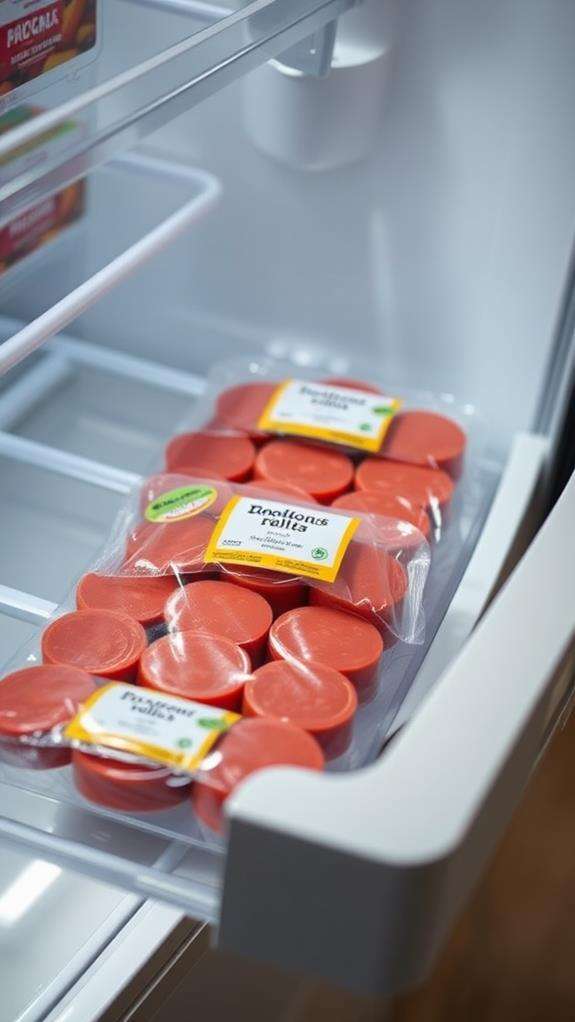
Unopened bologna wrapped in its original packaging can hold up for about 2 weeks in your refrigerator when stored at 40°F (4°C) or below. You'll want to check the "best by" date printed on the package, as this serves as your primary guideline for freshness. The vacuum-sealed packaging helps protect the meat from bacterial growth and oxidation, which are the main factors in meat spoilage.
To maximize your bologna's shelf life, you'll need to store it in the coldest part of your fridge, typically at the back rather than in the door compartment. The consistent temperature helps maintain the meat's quality and prevents premature spoilage. While the manufacturer's packaging is designed to preserve freshness, you should still inspect the bologna before its first use. Look for any signs of damage to the packaging, such as tears or punctures, which could compromise the meat's safety. If you notice any discoloration through the package, unusual odors when you first open it, or slimy texture, don't consume the bologna, even if it's within the expiration date. These are clear indicators that the meat has begun to spoil.
Storage Temperature Guidelines
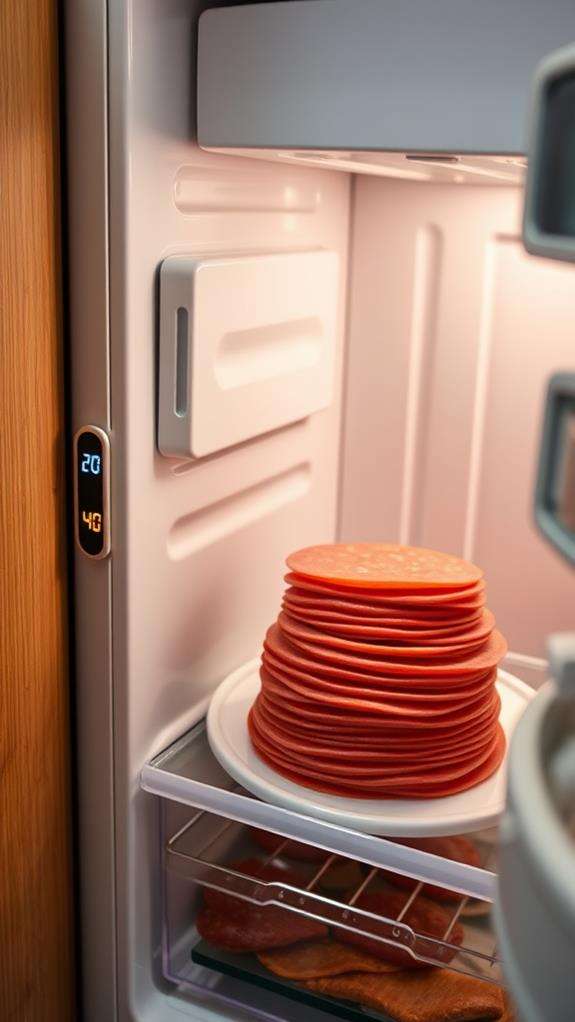
Proper temperature control is vital for bologna's safety and longevity. You'll need to maintain specific temperature ranges to prevent bacterial growth and preserve the meat's quality. Your refrigerator's temperature should stay between 33°F and 40°F (0.5°C to 4°C) to enhance bologna's shelf life and guarantee food safety compliance.
| Temperature Zone | Safe Range | Risk Level |
|---|---|---|
| Danger Zone | 40°F – 140°F | High Risk |
| Refrigeration | 33°F – 40°F | Safe Zone |
| Freezer | 0°F or below | Extended Storage |
When you're storing bologna, don't let it sit at room temperature for more than 2 hours. If the ambient temperature exceeds 90°F, reduce that time to just 1 hour. You'll want to place the bologna in the main compartment of your refrigerator, not in the door, where temperatures can fluctuate. If you're planning to freeze bologna, wrap it tightly in freezer paper or heavy-duty aluminum foil, then place it in a freezer bag to prevent freezer burn. Remember to monitor your refrigerator's temperature regularly using a reliable thermometer to maintain favorable storage conditions.
Signs of Spoiled Bologna

You'll need to watch for several key warning signs that indicate your bologna has spoiled, including discoloration, slimy texture, or any unusual spots on the surface. When examining your lunch meat, pay attention to any off-putting or sour smells, which are reliable indicators that bacteria has begun growing on the bologna. If you notice that the bologna feels unusually sticky, has changed from its original pink color to gray or brown, or gives off an unpleasant odor, it's time to throw it away rather than risk eating spoiled meat.
Visual Warning Signs
Through careful observation, you can spot several visual indicators that your bologna has spoiled. The most obvious sign is discoloration, where your bologna's typical pink or reddish hue changes to gray, brown, or even greenish tints. You'll also want to check for any slimy film on the surface, which develops when bacteria begin breaking down the meat.
If you notice any fuzzy spots or patches that appear white, blue, or green, you're looking at mold growth, and you should discard the bologna immediately. Don't attempt to cut away the moldy portions, as microscopic spores have likely spread throughout the meat. Watch for changes in texture too – if your bologna feels tacky or sticky to the touch, rather than smooth and slightly moist, it's starting to spoil.
Another critical visual cue is the presence of iridescent patches that might look like a rainbow sheen on the surface. While this rainbow effect isn't always a sign of spoilage (it can occur naturally due to light diffraction), when combined with other warning signs, it's best to err on the side of caution.
Smell and Texture Changes
Two reliable indicators of spoiled bologna are its smell and texture. When you're checking your bologna's freshness, trust your nose first – fresh bologna should have a mild, slightly smoky meat aroma. If you detect any sour, rancid, or off-putting smells, it's time to discard the meat, as these odors indicate bacterial growth and decomposition.
The texture of your bologna can tell you just as much about its condition. Fresh bologna should feel firm but slightly springy when you press it, and its surface should be smooth and slightly moist. You'll want to watch for several concerning changes: if it feels slimy or has a tacky coating, that's a clear sign of bacterial growth. When bologna develops a strange film or feels unusually sticky to touch, bacteria have likely begun breaking down the meat's proteins. Additionally, if your bologna feels unusually hard, dry, or has developed rough patches, it's probably past its prime. Your bologna shouldn't crumble or feel grainy – these textures indicate that the meat's structure has deteriorated and it's no longer safe to eat.
Proper Storage Methods

You'll get the best results storing bologna in an airtight container or resealable plastic bag rather than leaving it in its original packaging, which can trap moisture and speed up spoilage. For ideal freshness, keep your bologna in the refrigerator's meat drawer at a consistent temperature between 34-40°F (1-4°C), where humidity levels are better regulated. Remember to check that your container or bag is properly sealed after each use, as exposure to air can quickly compromise both the texture and safety of your bologna.
Container Vs Packaging Options
Several storage options exist for keeping bologna fresh in your refrigerator, with each method offering different levels of protection. You'll want to take into account both the original packaging and alternative storage containers to maintain ideal freshness.
When it comes to storing your bologna, you'll find these options particularly effective:
- Airtight plastic containers with snap-on lids provide excellent protection against cross-contamination and help prevent absorption of other food odors
- Resealable plastic bags with air expelled offer a space-saving solution while maintaining freshness, though they're less protective than rigid containers
- Original packaging with zip-seal capability can work well if it's still intact, but you should transfer the bologna once the package is opened
- Glass containers with rubber-sealed lids offer the most durable and non-porous storage option, though they require more space
For the best results, you'll want to wrap your bologna in wax paper or parchment paper before placing it in your chosen container. This additional barrier helps prevent moisture buildup and maintains the meat's texture. If you're using the original packaging, make certain it's tightly sealed after each use to prevent oxidation and bacterial growth.
Temperature and Humidity Control
Maintaining proper temperature and humidity levels is essential for maximizing bologna's shelf life in your refrigerator. You'll want to keep your fridge's temperature between 35°F and 40°F (1.7°C to 4.4°C), as this range effectively slows bacterial growth while preserving the meat's texture and flavor.
Your refrigerator's humidity level also plays a significant role in bologna storage. Set your crisper drawer to low humidity, as processed meats don't require the higher moisture levels that fresh produce needs. If you're storing bologna in the main compartment, place it toward the back of the shelf where temperatures remain most consistent and aren't affected by frequent door openings.
You can monitor your fridge's temperature using an inexpensive refrigerator thermometer, which you'll want to check regularly. If you notice condensation forming inside your bologna's storage container, that's a sign of excess humidity. To remedy this, you can wrap the bologna in a paper towel before storing it in your airtight container, as this will help absorb excess moisture and prevent premature spoilage.
Opened Package Storage Duration
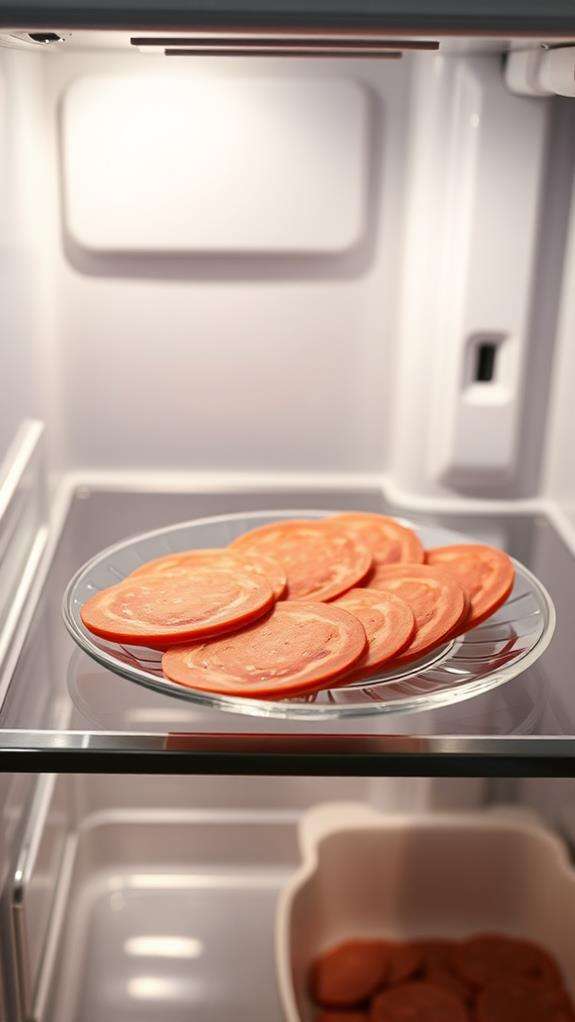
Once opened, bologna will last 3-5 days in the refrigerator when properly stored. You'll need to keep track of when you first opened the package and make certain you're following proper storage guidelines to maximize its shelf life. After opening, it's essential to reseal the package tightly or transfer the bologna to an airtight container to prevent bacterial growth and oxidation.
- Store opened bologna in the meat drawer of your refrigerator, where temperatures remain most consistent
- Use plastic wrap or aluminum foil to create an additional barrier if the original packaging can't be resealed
- Check for any signs of discoloration, odd smells, or slimy texture daily after opening
- Consider dividing larger quantities into smaller portions before storing to minimize handling
If you're not planning to consume the bologna within the 3-5 day window, you should freeze it immediately after opening. When frozen at 0°F (-18°C), bologna can maintain its quality for up to 2 months. Remember to date your packages and implement a first-in-first-out rotation system to make certain you're consuming the oldest opened packages first.
Freezing Bologna for Extended Life
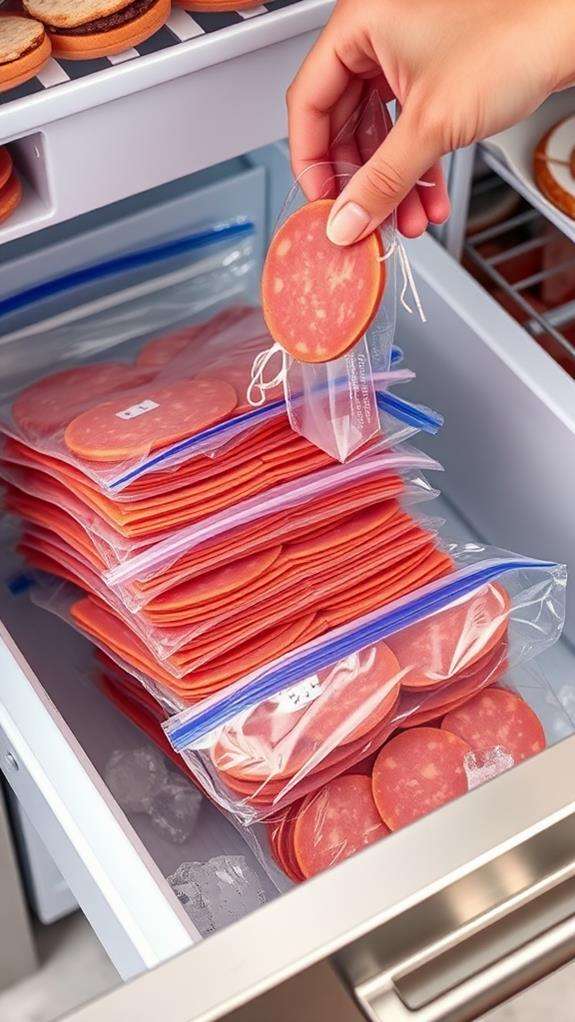
If you want to extend your bologna's shelf life beyond refrigeration, you can freeze it by wrapping individual portions tightly in plastic wrap and placing them in freezer-safe bags with the air pressed out. You'll find that properly frozen bologna maintains its quality for up to 2 months in a freezer set at 0°F (-18°C), though it remains safe to eat indefinitely at this temperature. When you're ready to use your frozen bologna, transfer it to the refrigerator and let it thaw gradually for 24-48 hours, never at room temperature, to maintain its texture and food safety.
Proper Freezing Methods
To maximize bologna's shelf life through freezing, you'll need to follow specific storage methods that prevent freezer burn and maintain quality. The most effective approach involves double-wrapping your bologna using both plastic wrap and heavy-duty aluminum foil, creating an airtight barrier against moisture and freezer burn.
When you're ready to freeze your bologna, follow these essential steps for ideal preservation:
- Remove the original packaging and slice the bologna if desired, then wrap each portion individually in plastic wrap, pressing out any air pockets
- Add a second layer using heavy-duty aluminum foil or freezer paper, ensuring all edges are tightly sealed
- Label each package with the date of freezing and contents using a permanent marker
- Place wrapped bologna in the coldest part of your freezer, typically toward the back, away from the door
Before sealing your bologna, you'll want to portion it according to your typical usage amounts. This strategy prevents repeated thawing and refreezing, which can compromise both texture and food safety. If you're freezing pre-sliced bologna, place wax paper between slices to prevent them from sticking together during the freezing process.
Maximum Storage Time
In the freezer, bologna maintains its best quality for up to 2 months when properly wrapped and stored at 0°F (-18°C) or below. While you can technically keep it frozen for longer periods, you'll notice the best flavor and texture within this two-month window.
You'll want to track your storage time carefully, as bologna's quality gradually declines even in frozen conditions. After the initial two months, you might notice changes in texture and taste, though it remains safe to eat if stored at constant freezing temperatures. It's helpful to label your packages with the freezing date using a permanent marker or freezer tape.
For maximum preservation, you shouldn't store frozen bologna beyond 4-6 months, even though it might still be safe to consume. If you notice any freezer burn, excessive ice crystals, or discoloration, it's best to discard the bologna. Remember that repeated freezing and thawing cycles will greatly impact the quality and safety of your bologna, so you should only thaw what you plan to use within a few days. Once thawed, you'll need to consume the bologna within 3-5 days.
Thawing Frozen Bologna
When it's time to use your frozen bologna, proper thawing methods guarantee both safety and quality. You'll want to plan ahead, as rushing the thawing process can compromise both texture and food safety. The safest method is to transfer your frozen bologna from the freezer to the refrigerator, allowing it to thaw gradually at a consistent temperature of 40°F or below.
- Never thaw bologna at room temperature on your counter, as this creates an ideal environment for bacterial growth
- Place frozen bologna on the bottom shelf of your refrigerator in its original packaging or a sealed container to prevent cross-contamination
- Allow approximately 24 hours of thawing time for every pound of bologna
- Once thawed, use your bologna within 3-5 days for peak freshness and safety
If you're in a hurry, you can use the cold water method by submerging the sealed package in cold water, changing the water every 30 minutes. This method typically takes 2-3 hours for a standard package. Remember, once you've thawed your bologna, you shouldn't refreeze it unless you've cooked it first, as this can affect both quality and safety.
Package Dating Explained
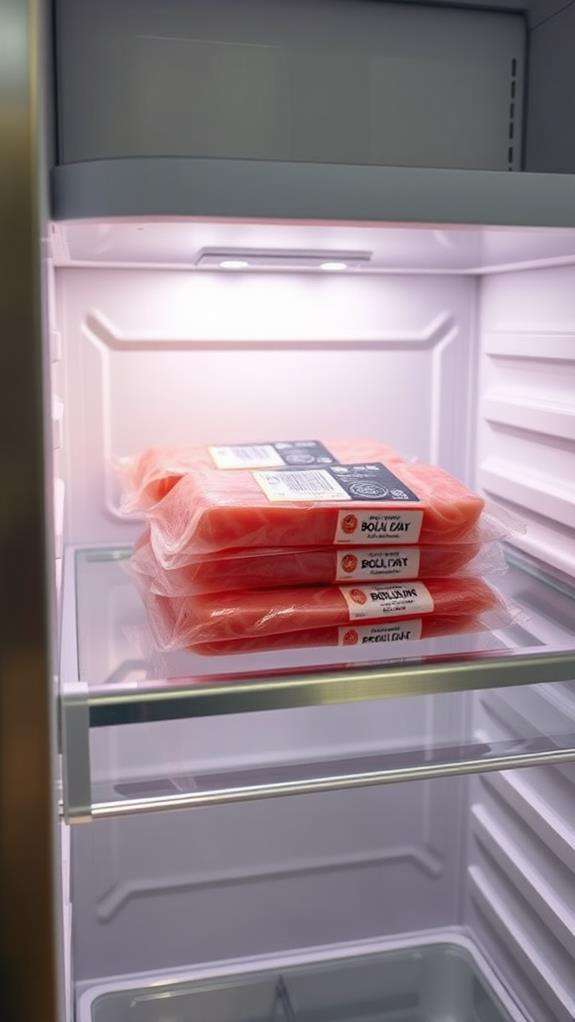
Understanding package dates on bologna can seem confusing since manufacturers use various dating methods and terminology. You'll typically find one of three main date types on your bologna package: "Sell-By," "Best-By," or "Use-By" dates.
A "Sell-By" date tells stores how long to display the product, but you can still eat the bologna for 3-7 days after this date if it's been properly refrigerated. The "Best-By" date isn't a safety date but indicates when the bologna will be at its peak quality. You'll find that bologna remains safe to eat for 1-2 weeks after this date if stored correctly. The "Use-By" date is the last date recommended for using the product while it's at its highest quality.
You should also check for a Julian date code, which manufacturers print as a series of numbers representing the production date. For example, "045" means the bologna was produced on February 14th (the 45th day of the year). If you're unsure about these dates, you can contact the manufacturer directly using the information provided on the package.
Best Storage Container Options
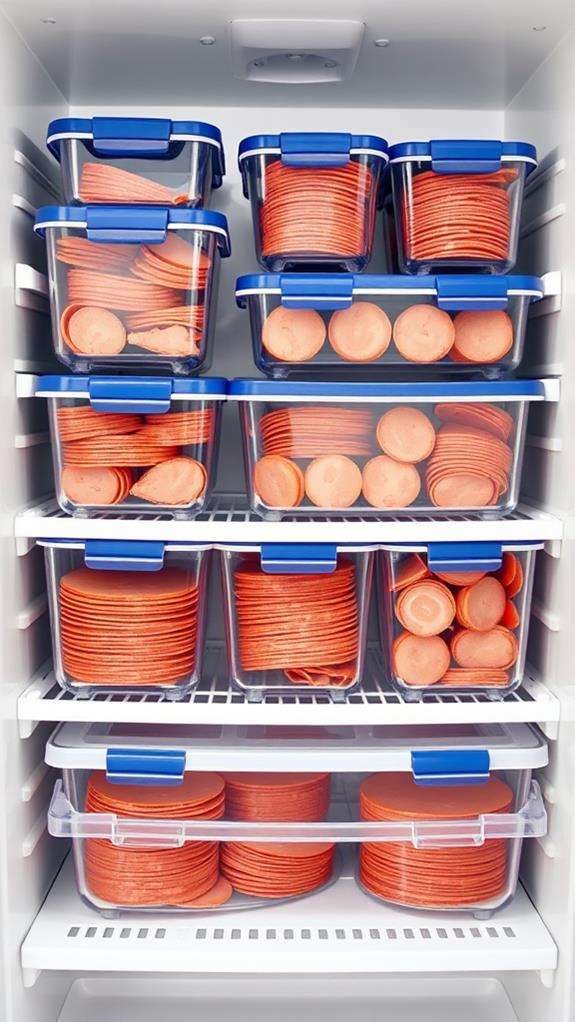
Proper storage containers make a considerable difference in keeping your bologna fresh longer. You'll want to choose an airtight container that prevents excess moisture and blocks out unwanted odors from other foods in your refrigerator. The best options include resealable plastic containers, vacuum-sealed bags, or specialized deli meat storage containers with moisture-control features.
- Glass containers with snap-locking lids provide excellent air-tight seals and won't absorb food odors, making them ideal for long-term storage
- BPA-free plastic containers with rubber gaskets offer a lightweight, cost-effective solution while maintaining freshness
- Vacuum-sealed bags remove excess air, greatly extending shelf life and preventing freezer burn if you're planning to freeze your bologna
- Specialized deli containers with built-in humidity controls help maintain ideal moisture levels, preventing both drying and excess condensation
When transferring bologna from its original packaging, you'll need to wrap it first in wax paper or plastic wrap before placing it in your chosen container. This double-barrier method creates an additional layer of protection against moisture and air exposure, helping maintain the meat's texture and preventing premature spoilage.
Food Safety Tips
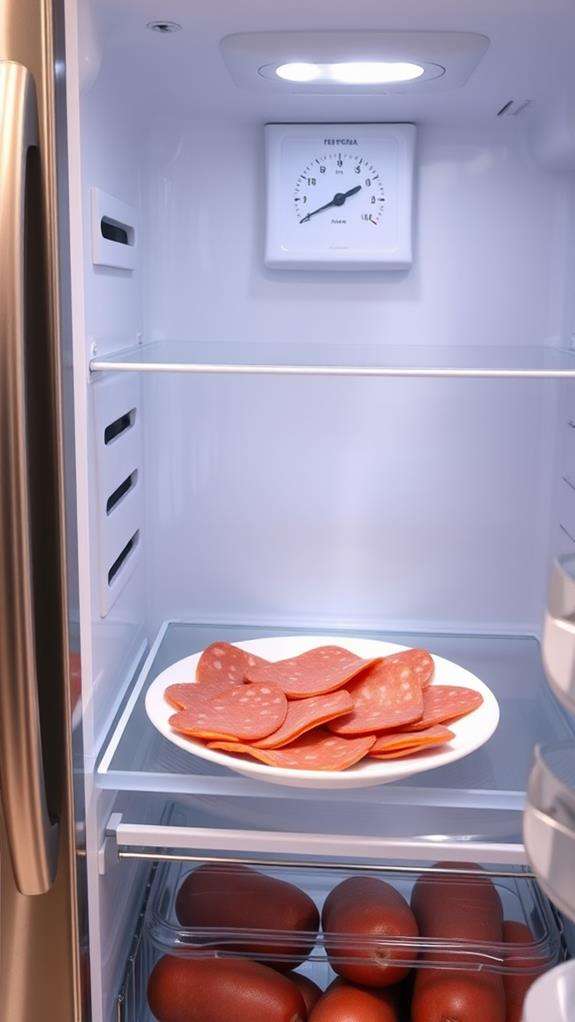
Safe handling practices go hand-in-hand with proper storage containers to keep your bologna fresh and safe to eat. When you're handling bologna, always wash your hands thoroughly with soap and warm water before and after touching the meat. You'll want to use clean utensils and cutting boards, and never let raw meat come into contact with your bologna.
Keep your refrigerator temperature at or below 40°F (4°C), and don't leave bologna out at room temperature for more than two hours. If you're packing bologna for lunch, use an insulated container with ice packs to maintain safe temperatures. When you're purchasing bologna, check the "sell by" date and make it one of your last items to pick up before checkout.
Watch for warning signs that your bologna has gone bad, such as an off-putting smell, slimy texture, or unusual coloring. If you spot any mold, discard the entire package immediately – don't try to cut around affected areas. Remember to close the package tightly after each use and place it in the coldest part of your refrigerator, typically at the back.
Common Storage Mistakes
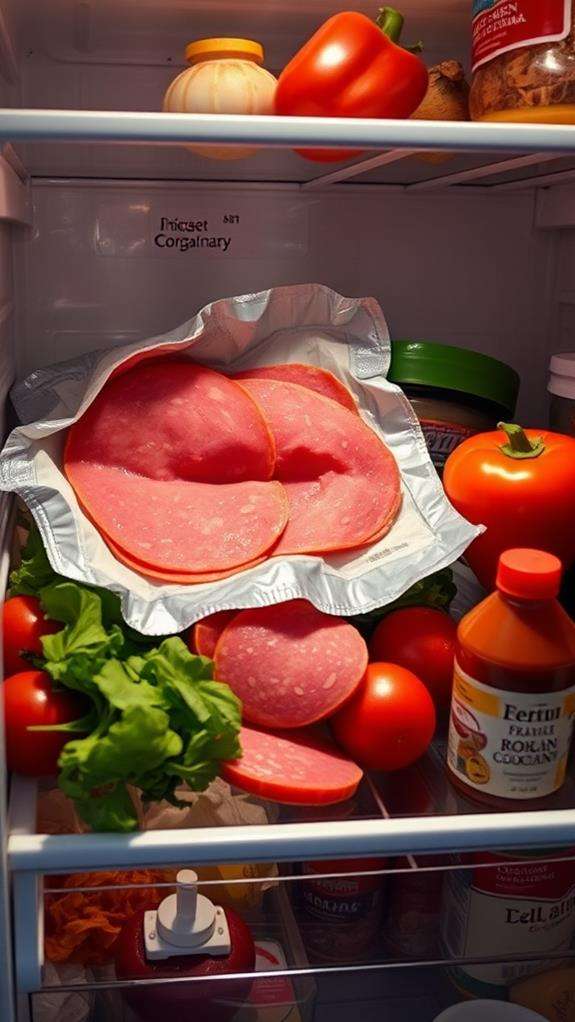
Despite good intentions, many people make critical mistakes when storing bologna that can greatly reduce its shelf life. You'll want to avoid these common errors to maintain your lunch meat's freshness and prevent premature spoilage, which can lead to both food waste and potential health risks.
- Storing bologna in its original packaging after opening, rather than transferring it to an airtight container or resealable plastic bag, which exposes it to excess air and moisture
- Placing the meat in the refrigerator door where temperature fluctuations occur frequently, instead of keeping it in the main compartment where temperatures remain more stable
- Stacking other items directly on top of your bologna package, which can damage the seal and cause contamination from leaking products
- Forgetting to check and maintain proper refrigerator temperature settings, which should stay at or below 40°F (4°C)
These storage mistakes can greatly impact your bologna's quality and safety. When you're storing lunch meat, it's essential to maintain consistent temperature control, minimize air exposure, and protect it from cross-contamination. By avoiding these common errors, you'll help guarantee your bologna stays fresh for its full storage duration.
Frequently Asked Questions
Can Bologna Be Safely Eaten Without Cooking It First?
Yes, you can safely eat bologna without cooking it first since it's a fully cooked meat product during manufacturing. The curing, smoking, and cooking processes it undergoes make it ready-to-eat straight from the package. However, you'll want to verify it's been properly refrigerated and hasn't expired. While you can heat bologna if you prefer it warm, it's perfectly safe to eat it cold in sandwiches or as a snack.
Does Homemade Bologna Last as Long as Store-Bought Bologna?
No, your homemade bologna won't last as long as store-bought varieties because it lacks commercial preservatives and isn't processed in a controlled environment. While store-bought bologna can last 1-2 weeks after opening in your fridge, homemade bologna typically stays fresh for only 3-5 days when properly stored. You'll want to keep it tightly wrapped and refrigerated at 40°F or below, and always check for any off-odors or unusual coloring before eating.
Why Does Bologna Sometimes Develop a Rainbow-Like Sheen on Top?
That rainbow sheen you're seeing on your bologna isn't a sign of spoilage – it's actually a natural phenomenon called protein iridescence. When light hits the meat's surface, it reflects off protein strands that have aligned during the curing and slicing process. You'll often notice this effect when the meat is sliced thinly and at certain angles. It's similar to how oil creates rainbow patterns on water, and it's completely safe to eat.
Can I Feed Expired Bologna to My Pets?
You shouldn't feed expired bologna to your pets, as it can cause serious health issues. Spoiled meat contains harmful bacteria that can lead to food poisoning in both cats and dogs. Even though your pets' digestive systems are different from humans, they're still vulnerable to foodborne illnesses. If you want to treat your pets, stick to fresh, pet-specific foods or consult your veterinarian for safe meal options.
Does Turkey Bologna Have a Different Shelf Life Than Regular Bologna?
While both types share similar preservation methods, turkey bologna typically has a slightly shorter shelf life than regular beef or pork bologna. You'll find that turkey's leaner composition makes it more susceptible to spoilage, usually lasting 3-5 days after opening compared to regular bologna's 5-7 days. Your best bet is checking the package date and watching for signs of spoilage like discoloration, off-odors, or slimy texture, regardless of variety.





